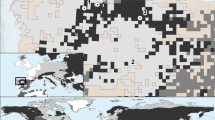Abstract
We present osteological evidence that a rhinocerotid skull belonging to a female Chilotherium wimani was bitten by a giant percrocutid, Dinocrocuta gigantea. Aided by comparative evidence of black rhino (Diceros bicornis) predation by extant spotted hyenas Crocuta crocuta, we interpret the healed wound on the C. wimani female as an injury incurred by the late Miocene D. gigantea. The hunting paleoecology of the giant percrocutid D. gigantea has long been speculated, but thus far no clear evidence has been discovered to point to the predatory habits of this carnivore. The present specimen of C. wimani provides evidence to indicate that the giant percrocutid shared similarities in predatory behavior to the modern spotted hyena: it was an active hunter in spite of the specialized bone-cracking craniodental morphology which imparted superb capability for processing bone.
Similar content being viewed by others
Abbreviations
- HMV:
-
vertebrate paleontology collection, Hezheng Paleozoological Museum, Gansu, China
- LX:
-
the locality prefix of Institute of Vertebrate Paleontology and Paleoanthropology, Chinese Academy of Sciences
References
Antunes M T, Balbino A C, Ginsburg L. Ichnological evidence of a Miocene rhinoceros bitten by a bear-dog (Amphicyon giganteus). Ann Paleont, 2006, 92: 31–39
Deng T. Character, age and ecology of the Hezheng Biota from northwestern China. Acta Geol Sin, 2005, 79: 739–750
Moodie R L. Paleopathology: An Introduction of the Study of Ancient Evidence of Disease. Urbana: University Illinois Press, 1923. 1–567
Courville C B. Cranial injuries in prehistoric animals. Bull Los Angeles Neurol Soc, 1953, 18: 117–126
Johnston C S. A skull of Osteoborus validus from the early middle Pliocene of Texas. Jour Paleont, 1939, 13: 526–530
Nelson M E, Madsen Jr H H. Late Pleistocene musk oxen from Utah. Kansas Acad Sci Trans, 1978, 81: 277–295
MacDonald J R. Pathological vertebrates from South Dakota. Bull Geol Soc Amer, 1951, 62: 1539
Bjork P R. The functional significance of a broken incisor in Amphicaenopus, an Oligocene rhinocerotid. Proc South Dakota Acad Sci, 1978, 57: 163–167
Lucas S G, Schoch R M. Paleopathology of early Cenozoic Coryphodon (Mammalia: Pantodonta). Vert Paleont, 1987, 7: 145–154
Green M. Pathologic vertebrate fossils and recent specimens. Proc South Dakota Acad Sci, 1961, 40: 142–148
Schultz A H. Notes on diseases and healed fractures of wild apes. In: Brothwell D, Sandison A T, eds. Diseases in Antiquity: A Survey of the Diseases, Injuries, and Surgery of Early Populations. Springfield: Thomas, 1967. 47–55
Kruuk H. The Spotted Hyena: A Study of Predation and Social Behavior. Chicago: University Chicago Press, 1972. 1–335
Tseng Z J. Cranial function in a late Miocene Dinocrocuta gigantea (Mammalia: Carnivora) revealed by comparative finite element analysis. Biol Linnean Soc, 2009, 96: 51–67
Ringström T. Nashörner der Hipparion Fauna Nord-Chinas. Palaeont Sin Ser C, 1924, 1: 1–156
Agusti J, Antón M. Mammoths, Sabertooths, and Hominids. New York: Columbia University Press, 2002. 1–313
Rothschild B M, Martin L D. Paleopathology: Disease in the Fossil Record. Boca Raton: CRC Press, 1993. 1–352
Rhinelander F W. Tibial blood supply in relation to fracture healing. Clin Orthopedics, 1974, 105: 34–81
Miller G J. Some new evidence in support of the stabbing hypothesis for Smilodon californicus Bovard. Carnivore, 1980, 3: 8–26
Schlosser M. Die fossilen Säugethiere Chinas nebst einer Odontographie der recenten Antilopen. Abh Kön Bayer Akad Wiss, 1903, 22: 1–221
Qiu Z X, Xie J Y, Yan D F. Discovery of the skull of Dinocrocuta gigantean (in Chinese). Vert PalAsiat, 1988, 26: 128–138
Deng T, Wang X M, Ni X J, et al. Cenozoic stratigraphic sequence of the Linxia Basin in Gansu, China and its evidence from mammal fossils (in Chinese). Vert PalAsiat, 2004, 42: 45–66
Turner A, Antón M, Werdelin L. Taxonomy and evolutionary patterns in the fossil Hyaenidae of Europe. Geobios, 2008, 41: 677–687
Guérin C. Palaeoecological study of Arrisdrift mammals. Mem Geol Surv Namibia, 2003, 19: 385–388
Carbone C, Mace G M, Roberts S C, et al. Energetic constraints on the diet of terrestrial carnivores. Nature, 1999, 402: 286–288
Sorkin B. A biomechanical constraint on body mass in terrestrial mammalian predators. Lethaia, 2008, 41: 333–347
Carbone C, Du Toit J T, Gordon I J. Feeding success in African wild dogs: Does kleptoparasitism by spotted hyenas influence hunting group size? Animal Ecol, 1997, 66: 318–326
Hayward M W. Prey preferences of the spotted hyaena (Crocuta crocuta) and degree of dietary overlap with the lion (Panthera leo). Jour Zool, 2006, 270: 606–614
Salnicki J, Teichmann M, Wilson V J, et al. Spotted hyaenas Crocuta crocuta prey on new-born elephant calves in Hwange National Park, Zumbabwe. Koedoe, 2001, 44: 79–83
Cullen A. A Window onto Wilderness. Nairobi: East African Publshing House, 1969, 1–185
Deane N N. The spotted hyaena Crocuta crocuta crocuta. Lammergeyer, 1962, 2: 26–44
Liang Z, Deng T. Age structure and habitat of the rhinoceros Chilotherium during the late Miocene in the Linxia Basin, Gansu, China (in Chinese). Vert PalAsiat, 2005, 43: 219–230
Author information
Authors and Affiliations
Corresponding author
About this article
Cite this article
Deng, T., Tseng, Z.J. Osteological evidence for predatory behavior of the giant percrocutid (Dinocrocuta gigantea) as an active hunter. Chin. Sci. Bull. 55, 1790–1794 (2010). https://doi.org/10.1007/s11434-010-3031-9
Received:
Accepted:
Published:
Issue Date:
DOI: https://doi.org/10.1007/s11434-010-3031-9




